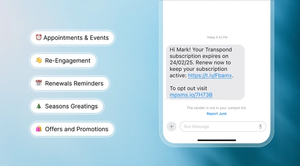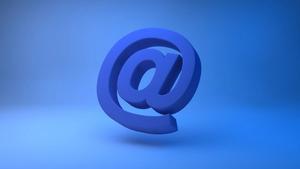It’s been more than 30 years since email was first used as a method of communication, and email marketing is still one of the most effective ways to reach your target audience. It’s harder than ever to create email content that stands out against your direct competitors and other organizations vying for your recipient’s attention.
We’re delving into the world of B2B email marketing: what makes it different, the dos and don’ts, and how you can create a B2B email marketing strategy that drives tangible results.
What is B2B email marketing?
B2B email marketing is the practice of using email marketing as a channel to promote products and services to other businesses. B2B email marketing is focused on reaching people in appropriate organizations and businesses. Both the individual and the organization should fit your ideal customer profile (ICP).
There are a number of different emails that can be used in your B2B marketing campaigns including welcome emails, transactional emails, promotions, newsletters, and educational guides, amongst many more.
Email marketing is more affordable and easier to scale compared to channels like paid ads.
B2B vs B2C email marketing
Email marketing varies between B2B and B2C: it’s a common mistake that you can use the same approach across the two. So how can you distinguish B2B email marketing from B2C? Let’s look at how they differ.
The audience
In B2B email marketing, you're primarily sending content to other businesses. And while you may only target one person, your compelling content is likely to be shared with team members and, ideally, key decision-makers.
A brand sending B2C marketing emails intends to reach the buyer immediately, encouraging them to click through to their site, browse, and checkout.
By contrast, B2B sales take much longer and often involve many stakeholders. This means that the content you send can be shared and reviewed by several people before they make a purchase.
The type of content
Like B2B content marketing, B2B email marketing involves sharing content that demonstrates your product’s benefits and features, and highlighting useful blogs, guides, and case studies.
On the other hand, B2C emails incorporate content directly related to the product, like upcoming promotions, discounts, and product benefits.
The tone and language
Generally, you’ll find B2B marketing emails more formal than their B2C counterpart. If your brand voice is fun and friendly, it should shine through the copy even if it’s a little more formal than the copy found in your social media posts.
The language used in B2B is usually industry-specific, using acronyms and phrases relevant to your audience.
B2C marketing strategies typically adopt a more engaging, fun, and relaxed tone. Consider the style B2C brands use on social media marketing - it’s often consistent with their email marketing and other communications.
Personalization strategy for potential customers
In B2B email marketing, the email subject line and content are tailored to the recipient's industry, company size, job role, and in some cases, previous interactions with the brand.
For B2C marketing efforts, the personalization is based on previous customer purchases, demographics, browsing behavior, and any other information the customer willingly provides, such as their interests, for example.
Sales cycle
In B2B, it can take weeks and even months from the prospect’s first contact with your brand until they eventually convert to a paying customer.
There are typically many stakeholders involved and getting a decision and a signature can require multiple touchpoints. That’s why the average email marketing campaign in B2B comprises a sequence of email messages instead of just one.
B2C sales cycles are much shorter and focus on sending targeted messages to potentially interested audiences. Instead of nurturing leads through their customer journey, the end goal is an immediate conversion.
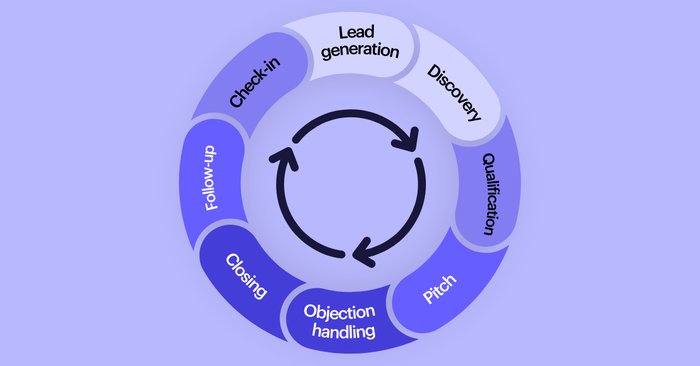
Email frequency
Although B2B emails have valuable information and personalized subject lines, if you send them too often you'll do more harm than good. Even if you’re targeting existing clients with relevant content, sending too many emails will be harmful.
In B2C email marketing, you can typically send many more emails. Especially in peak seasons such as holidays, it's not uncommon to send out emails every day.
Email design
Most B2B email marketing campaigns have simplistic emails focused on text only. The aim is to provide useful information and get the recipient to click on the CTA without wasting too much time exploring the graphics.
On the other hand, B2C marketers use a variety of digital marketing tools to create colorful, engaging, and fun emails. In fact, many B2C emails are entirely built around graphics.
How to launch a successful B2B email marketing strategy, step by step
Are you ready to make email marketing the most successful sales channel for your B2B operations? We'll walk you through the entire process, from start to finish.
Define your B2B email marketing goals
While the ultimate goal of every email marketing campaign is to drive new sales, it’s not the goal of every single email campaign.
Before setting out to create your first email campaign, identify your overall goals. This helps you choose the right methods to achieve them.
Here are some B2B email marketing goals your company could consider:
- To generate leads for your business;
- To nurture existing leads and guide them further down the sales funnel;
- Promote a new product and distribute information about its benefits;
- Create thought leadership content and distribute it to your existing subscribers;
- Re-engage customers with valuable content related to your product and brand;
- Qualify new subscribers and push them further down the sales funnel.
The goals you set will shape everything. From the number of emails in your sequences and the way you segment your audiences, to the buyer personas you target.
Marketers should ensure that their B2B email marketing strategy aligns with their overall marketing and sales goals. This is especially true if they plan to invest significant time and money in email marketing as a channel.
Identify your target audience
Business-to-business emails typically don't have as many options for personalization as their B2C counterparts. But this doesn’t mean you shouldn’t personalize your communications. A well-defined email marketing strategy targets a specific set of customers.
Here are some of the ways you can segment your customer base:
- By industry and niche
- By location
- By business size
- By pain points
- By job function
- By previous interactions with your brand
For example, your target audience could be senior marketing managers working in the logistics industry in businesses located in the eastern United States, with 50-100 employees and annual recurring revenue of over two million dollars.
To get new customers from your email marketing efforts, you can research buyer personas. These personas can give a glimpse of the customer data you need for your strategy.
All these relevant details should be stored in your customer relationship management (CRM) tool.
A platform such as Capsule CRM can speed up your sales process and power up email marketing automation further down the line. If you have a lot of contacts, a CRM can help you focus on your desired audiences and target markets. This brings us to our next point.

Build and segment your list of targets
The most difficult part about B2B email marketing is not just creating email marketing campaigns.
It's building a list of contacts that you can send messages to. A good email list is a valuable resource that can improve your sales and marketing efforts and help you close new deals. However, it can be difficult to get off the ground if you’re new to email marketing.
There are a few options here:
- Using lead generation software to identify lists of emails with your requirements.
- Offering something of value to your website visitors to generate leads, e.g. a free guide that someone downloads after entering their email address.
The third option is not one we would ever recommend: buying email lists. It's not only ineffective but also illegal in most countries. Purchased lists can contain risky emails. For example, outdated emails, spam traps, and irrelevant emails to your industry and target audiences.
Generating lists of leads from your own data is the best way to start an email campaign. This way, you'll know for sure that they’re interested in what you have to say and sell.
Once you have a list of leads you can reach out to, you can segment that list to send more personalized content.
Choose an email marketing platform
Sending out email campaigns requires specialized software that can send high volumes of messages and ensure that each is highly personalized and flows as a part of a sequence.
These tools integrate with your CRM and help create campaigns for your entire audience or specific segments. Our go-to platform is Transpond, which seamlessly integrates with Capsule to create effective email campaigns.
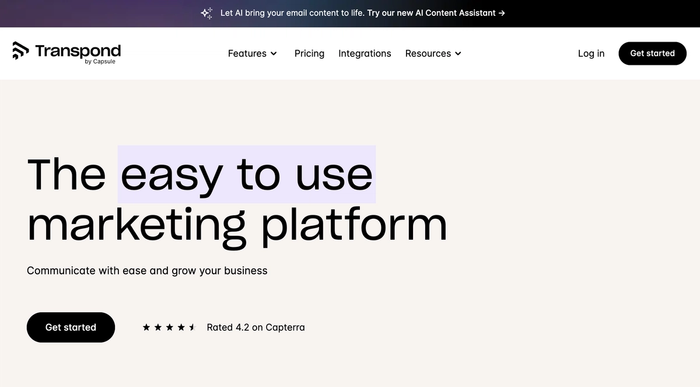
Offering marketing automation, contact list segmentation, and advanced email analytics, Transpond is an easy-to-use marketing platform that gives you all the tools you need to communicate with and convert your contacts.
Create compelling email content
Arguably one of the hardest things about B2B email marketing is creating engaging content for your old and new users for the right stage of their customer journey.
In the world of B2B, this is primarily educational content to remind customers why yours is the leading solution to their pains.
You can offer your audience free tools, exclusive access to your programs, guides, checklists, and anything that could help resolve their challenges – even in other areas of their business.
Unfortunately, there are no shortcuts, and you have to find out which email subject lines, types of content, and calls to action work best for your potential customers.
Use responsive email templates
Unlike your website, there’s not much room for creativity when it comes to the imagery you can add to your B2B email marketing campaigns.
However, most email marketing tools offer templates to build from which use responsive email templates. These are frameworks for emails that are responsive, which means that they look and function well across different devices, such as mobile phones, tablets, and laptops. And since almost 62% of emails nowadays are first opened on mobile, it's essential to have this point covered.
From your welcome email to the closing offer, test how your emails look on all devices before sending out a campaign.
Set up automated workflows for your emails
Implementing automation to your B2B marketing strategy saves a lot of time, and as a result, money. As long as you can budget for an automated email service, try to avoid sending email campaigns manually.
Here are some of the things you can set up and automate:
- Welcome emails for all new subscribers
- Segmentation of new subscribers based on their form submissions
- The flow of emails: how many emails subscribers get and when in the customer journey;
- What happens when someone opens an email
- What happens when someone clicks through an email
- When to launch re-engagement campaigns
A good combination of CRM and email marketing software ensures that you personalize each campaign, from the subject line to the CTA.
Test and optimize your campaigns
B2B email marketing means taking data into account. To find out which subject line works, which type of email body drives the best business results, and which CTA gets the best CTRs, you should test and optimize each of your campaigns.
Email marketing software like Transpond makes this a breeze. The reason is that you get analytics for every campaign that goes out. You can even compare two different versions of the same email against each other to see which one drives higher CTRs and conversion rates.
Over time, you can hone your B2B email marketing skills to create the kind of emails that attract new users, guide them through the sales funnel, and convert them into paying customers.
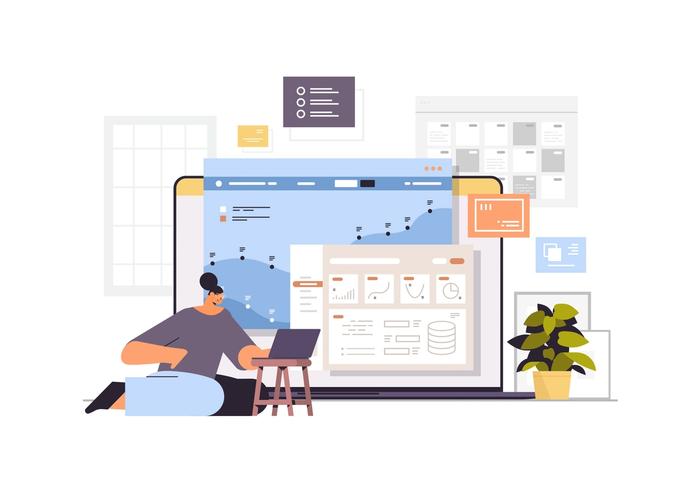
Top B2B email marketing mistakes to avoid
It’s easier than ever to launch a B2B email marketing strategy. With readily available tools, sales intelligence tools, and playbooks to follow, anyone confidently get started with email marketing.
Here are some mistakes you should try to avoid from the start.
Lacking personalization
On the face of it, email marketing seems easy: simply drafting up a single email, with an email subject line, body, and CTA. But your audience likely works in different regions, diverse industry niches, and with various budgets. If you're talking to everyone the same way, you're not speaking to anyone specifically.
Combine your CRM data with email outreach tools and templates to create personalized email messages based on audience segments. You can personalize based on various criteria, such as:
- Location
- Job title
- Industry
- Which of your services they’ve shown interest in
- Their previous interactions with your brand
Personalized emails get 29% higher unique open rates and have 41% more click-throughs. It’s easily automated with the right kind of tools, making personalization a no-brainer.
Not providing clear CTAs
Don't leave it up to the recipient to determine what they should do after reading your email.
No matter what type of email you’re sending, its position in the email sequence, or the target audience, every email should have a clear purpose and call to action. Avoid using multiple calls to action to help the reader understand the next steps.
Some examples could include:
- Booking a demo with your team
- Downloading a free resource
- Trialling your product for free
- Upgrading from a trial to a paid account
- Filling out a survey for customer success teams
The CTA typically goes at the end of the email, following relevant but concise information to encourage the reader to click. The CTA should be short, snappy, and easy to understand. For example ‘Book your free demo’, or ‘Sign up now’.
However, in long-form emails, like content newsletters, it makes sense to drip-feed a handful of CTAs throughout.
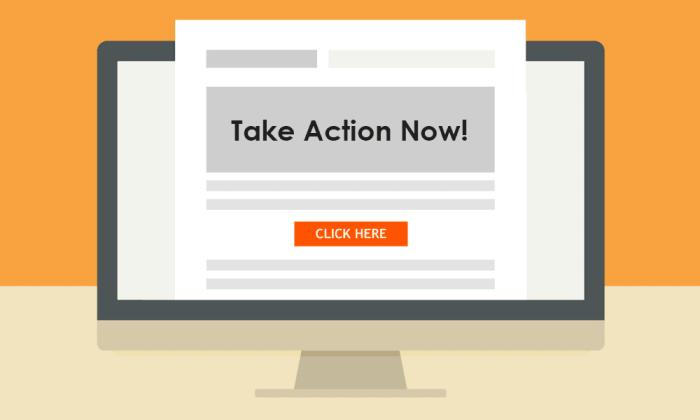
Just make sure that the CTAs help achieve the goal of the email, e.g. prompt webinar sign-ups, encourage up-sales, or drive clicks through to your website.
Not following up
Sending multiple emails can be tedious, but it's necessary. According to research, 80% of sales efforts require at least 5 follow-ups. At the same time, 44% of sales professionals give up after one follow-up attempt.
Just a few years ago, following up meant looking at the emails you've sent and manually reaching out to everyone who didn't reply. Nowadays, you can schedule your follow-up emails with automation. You can also exclude the addresses that have already replied to prevent yourself from spamming the same accounts.
With condition-based rules, your email marketing strategy becomes even more sophisticated.
Imagine you send a welcome email to a group of subscribers. Some of them click on a link in the email, while others don't. You can schedule two different types of follow-ups and create audiences based on whether someone clicked a link or not.
Forgetting about compliance
Many businesses fall into the trap of neglecting regulations such as GDPR. While they may seem like a pain in the neck, it's a legal necessity to stay in the loop and be compliant.
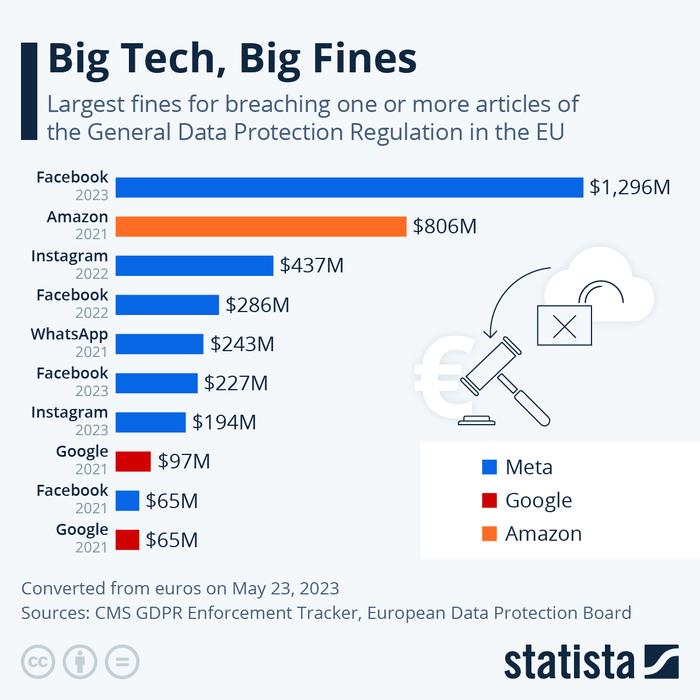
Most importantly, a company should not send emails to people who have given their explicit consent to be on a mailing list. Failure to comply with GDPR can cost your business large fines.
Read our guide to compliance and respectful communication in email marketing.
Neglecting email analytics
While you might feel concerned about conversions and revenue from email marketing, these might only be symptoms of other problems, rather than the issues themselves.
Modern email marketing software has detailed analytics dashboards, breaking down every relevant metric in your campaigns. Some of the most important metrics are:
- Open rate
- Click-through rate
- Bounce rate
- Deliverability rate
- Unsubscribed users
- List growth rate
Being familiar with these values can improve your decision-making process and help you determine the reasons behind a campaign's performance.
Perhaps you could optimize your subject line, improve the visual layout, or simply make the aim of each email clearer with more concise and straightforward messaging. For instance, if the purpose of the email is to encourage your recipients to sign up for your upcoming webinar, don’t include links to other blogs or irrelevant information.
You could also A/B test the copy used in your CTAs or include more personalization.
Too-frequent emails
You’ve probably found yourself the victim of spamming: receiving hoards of emails from a business after providing your email address simply to download content or sign up for a webinar.
For B2C brands, sending an email every day might be a good rule of thumb. In B2B, daily emails often pester recipients who are in the middle of work. The optimum frequency of emails is more likely two to three times a week - but you can’t guarantee this won’t bother your audience.
One way to avoid overwhelming your contacts is to to ask for their preferences as soon as they opt-in on your website.
Over time, track the performance with your chosen number of emails. If the engagement is decreasing, consider sending fewer emails to this audience.
Ignoring segmentation
Segmenting a list entails sending multiple smaller campaigns instead of one that goes out to an entire list.
Segmented email campaigns result in 760% more revenue compared to sending the same email to one large list of subscribers.
This could mean targeting different personas inside your ICP, or organizations by their revenue for example.
Conclusion: B2B email marketing
B2B email marketing has its own rules and guidelines that drive valuable results. The process we laid out today can help you win new subscribers, convert your existing recipients, and make more revenue. Refer regularly to the pitfalls of B2B email marketing above to avoid falling foul of data regulations, pestering your contacts, or simply offering unengaging content.
Before you set about sending emails, you need to ensure you’re targeting the right people using the right contact information. This is where a CRM tool comes in.
Capsule offers an easy, intuitive way to store contact, organization, and opportunity datasets, which enables you to reach out to your leads with personalized messages, segment your database, and keep track of communications.



